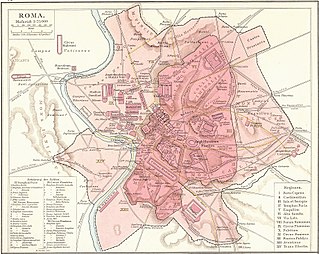
The Domus Aurea was a vast landscaped palace built by the Emperor Nero in the heart of ancient Rome after the great fire in 64 AD had destroyed a large part of the city and the aristocratic palaces on the Palatine Hill.

The Golden Legend is a collection of hagiographies by Jacobus de Varagine that was widely read in late medieval Europe. More than a thousand manuscripts of the text have survived. It was likely compiled around the years 1259–1266, although the text was added to over the centuries.

Saint Giles, also known as Giles the Hermit, was a Greek, Christian, hermit saint from Athens, whose life is centered in Provence and Septimania. Giles founded the abbey in Saint-Gilles-du-Gard whose tomb became a place of pilgrimage. It was a stop on the road that led from Arles to Santiago de Compostela, the pilgrim Way of St. James. Giles is one of the Fourteen Holy Helpers.

The Lei Áurea, adopted on May 13, 1888, was the law that abolished slavery in Brazil. It was signed by Isabel, Princess Imperial of Brazil (1846–1921), an opponent of slavery, who acted as regent to Emperor Pedro II, who was in Europe.
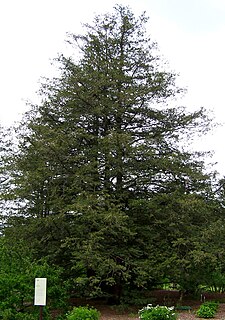
Chamaecyparis pisifera is a species of false cypress, native to central and southern Japan, on the islands of Honshū and Kyūshū.
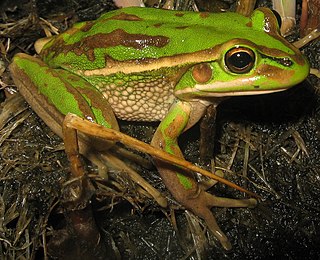
The green and golden bell frog, also named the green bell frog, green and golden swamp frog and green frog, is a ground-dwelling tree frog native to eastern Australia. Despite its classification and climbing abilities, it does not live in trees and spends almost all of its time close to ground level. It can reach up to 11 cm (4.5 in) in length, making it one of Australia's largest frogs.

The hybrid elm cultivar Ulmus × hollandica 'Wredei', also known as Ulmus × hollandica 'Dampieri Aurea' and sometimes marketed as Golden Elm, originated as a sport of the cultivar 'Dampieri' at the Alt-Geltow Arboretum, near Potsdam, Germany, in 1875.

The Field Elm cultivar Ulmus minor 'Viminalis Aurea', probably a "golden" form of Ulmus minor 'Viminalis', was raised before 1866 by Egide Rosseels of Louvain, who was known to have supplied 'Viminalis'.
The hybrid elm cultivar Ulmus × hollandica 'Macrophylla Aurea' was listed by Bean in Kew Hand-List Trees & Shrubs, ed. 3, 273, 1925 as U. montana var. macrophylla aurea, but without description.

Protea aurea, the long-bud sugarbush, is a shrub or small tree with a single trunk occurring in mountain fynbos, usually on cool, moist, southern slopes. It is endemic to the Cape Provinces of South Africa.

Ficus aurea, commonly known as the Florida strangler fig, golden fig, or higuerón, is a tree in the family Moraceae that is native to the U.S. state of Florida, the northern and western Caribbean, southern Mexico and Central America south to Panama. The specific epithet aurea was applied by English botanist Thomas Nuttall who described the species in 1846.

The Puerto Rico women's national volleyball team is one of the more consistent teams of the NORCECA zone, Puerto Rico has taken one silver and two bronzes on the NORCECA Women's Volleyball Championship, one silver and two bronzes at the Pan-American Cup, and five silvers and one bronze at the Central American and Caribbean Games. The team has participated at least once in all FIVB competitions, except for the World Cup.
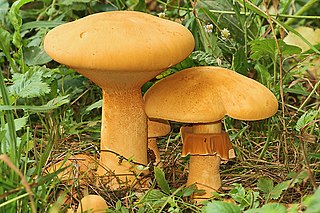
Phaeolepiota is a genus of fungi in the family Agaricaceae. This is a monotypic genus, containing the single species Phaeolepiota aurea. P. aurea, commonly known as golden bootleg or golden cap is a mushroom found throughout North America and Eurasia – often next to nettles. It is not recommended for human consumption due to the possible presence of toxins causing gastrointestinal upset.
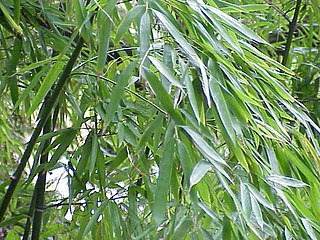
Phyllostachys aurea is a species of bamboo, and is of the 'running bamboo' type, belonging to the diverse Bambuseae tribe. It is native to Fujian and Zhejiang in China. It is commonly known by the names fishpole bamboo, golden bamboo, monk's belly bamboo, and fairyland bamboo (Australia).
Grevillea aurea, commonly known as the Golden grevillea or the Deaf Adder Gorge grevillea, is a shrub native to the Northern Territory in Australia.

Daubenya is a genus of bulbous flowering plants in the family Asparagaceae, subfamily Scilloideae. It is native to the Cape Province of South Africa.

Daubenya zeyheri (Kunth) J.C.Manning & A.M.van der Merwe is one of 8 bulbous species in the genus, all endemic to the winter rainfall Strandveld of South Africa, and mostly growing on doleritic clays along the West Coast, Western Cape. It is closely related to Daubenya marginata J.C.Manning & A.M.van der Merwe. At first believed to consist of a single species, Daubenya aurea, the genus was expanded in 2000 to include the genera Androsiphon and Amphisiphon and various species that had previously been classified as Polyxena, Massonia, or Neobakeria. "The poor congruence between morphological and other characters within Hyacinthaceae has also made generic circumscriptions very difficult. One of the consequences of this has been the recognition of a large number of genera that are poorly defined morphologically." - All 8 species have two spreading, prostrate leaves and tubular flowers that range from white to yellow or red, and in 6 of the species are followed by smooth glossy seeds within papery capsules that lend themselves to anemochory or wind dispersal. The inflorescence is produced at ground level on a sub-surface peduncle between the two leaves. Species are variously pollinated by bees, butterflies, moths, the monkey beetle Lepisia glenlyonensis and sunbirds. The water-retaining nature of doleritic clays ensures their remaining moist for longer than clays formed from shales of the Karoo series. Exceptionally D. namaquensis is found in deep red sands and D. zeyheri in calcareous coastal sands.

Echinopsis aurea, is a species of Echinopsis found in Argentina.

Protea aurea subsp. potbergensis, also known as the Potberg protea, or Potberg sugarbush, is a flowering plant of the genus Protea. It is endemic to South Africa and is found only in the Potberg near Cape Infanta. It grows to a height of 5 metres, and flowers primarily from May to June.


















